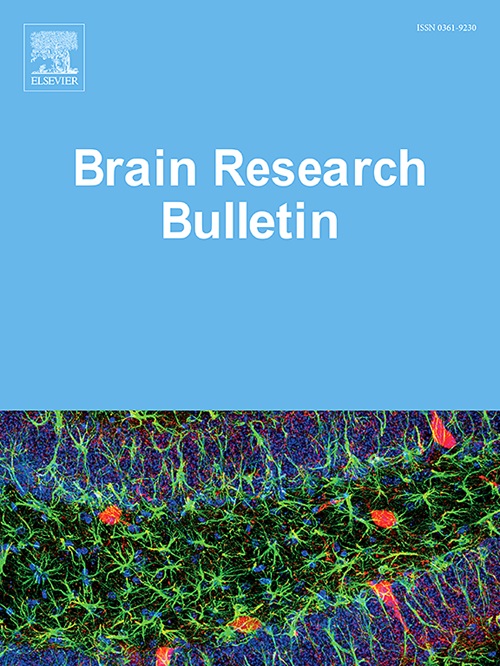Cerebellum abnormalities in vascular mild cognitive impairment with depression symptom patients: A multimodal magnetic resonance imaging study
IF 3.5
3区 医学
Q2 NEUROSCIENCES
引用次数: 0
Abstract
Background
Subcortical vascular mild cognitive impairment (svMCI) frequently occurs alongside depression symptoms, significantly affecting patients' quality of life. While cognitive decline and depression symptoms are linked to cerebellar changes, the specific relationship between these changes and cognitive status in svMCI patients with depression symptoms remains unclear.
Objective
This study aimed to investigates the gray matter volume and functional alterations in the cerebellum of svMCI patients, with and without depression symptoms, and their correlation with cognitive and depressive symptoms.
Methods
We enrolled 16 svMCI patients with depression symptoms (svMCI+D), 15 without (svMCI-D), and 12 normal controls (NC). Multimodal MRI scans were conducted, assessing gray matter volume and resting-state functional connectivity (RSFC) in the cerebellum. Correlations between RSFC and clinical scores from the Montreal Cognitive Assessment (MoCA) and Hamilton Depression Scale (HAMD) were analyzed.
Results
Structural analysis indicated gray matter atrophy in left cerebellar lobules I_IV and VI (Cere6.L) in svMCI patients. svMCI+D patients showed reduced RSFC between Cere6.L and left cerebellar region IX and the left superior frontal gyrus (SFGdor.L). Both svMCI+D and svMCI-D groups showed increased RSFC between Cere6.L and the right caudate nucleus. RSFC between Cere6.L and SFGdor.L correlated negatively with HAMD scores in svMCI+D and positively with MoCA scores in svMCI-D. RSFC between Cere6.L and the right caudate nucleus also correlated positively with MoCA in the svMCI-D.
Conclusion
Cerebellar abnormalities, including the gray matter atrophy and RSFC changes, are associated with svMCI, particularly when depression symptoms are present. These results suggest potential diagnostic and therapeutic implications for svMCI and emphasize the need for further research on the cerebellum's role in cognitive and emotional disorders.
血管性轻度认知障碍伴抑郁症状患者小脑异常:多模态磁共振成像研究。
背景:皮层下血管性轻度认知障碍(svMCI)常伴发抑郁症状,显著影响患者的生活质量。虽然认知能力下降和抑郁症状与小脑变化有关,但这些变化与伴有抑郁症状的svMCI患者认知状态之间的具体关系尚不清楚。目的:探讨伴有和不伴有抑郁症状的svMCI患者小脑灰质体积和功能改变及其与认知和抑郁症状的相关性。方法:16例伴有抑郁症状的svMCI患者(svMCI+D)、15例无抑郁症状的svMCI患者(svMCI-D)和12例正常对照(NC)。进行多模态MRI扫描,评估小脑灰质体积和静息状态功能连接(RSFC)。分析RSFC与蒙特利尔认知评估(MoCA)和汉密尔顿抑郁量表(HAMD)临床评分的相关性。结果:结构分析显示svMCI患者左小脑i、i小叶(Cere6.L)灰质萎缩。svMCI+D患者在Cere6和Cere6之间表现为RSFC减少。左小脑九区和左额上回(SFGdor.L)。svMCI+D组和svMCI-D组在Cere6之间均显示RSFC升高。L和右侧尾状核。RSFC之间的Cere6。L和sfgor。L与svMCI+D组HAMD评分负相关,与svMCI-D组MoCA评分正相关。RSFC之间的Cere6。在svMCI-D中,L和右尾状核也与MoCA呈正相关。结论:小脑异常,包括灰质萎缩和RSFC改变,与svMCI有关,特别是当出现抑郁症状时。这些结果提示了svMCI的潜在诊断和治疗意义,并强调需要进一步研究小脑在认知和情绪障碍中的作用。
本文章由计算机程序翻译,如有差异,请以英文原文为准。
求助全文
约1分钟内获得全文
求助全文
来源期刊

Brain Research Bulletin
医学-神经科学
CiteScore
6.90
自引率
2.60%
发文量
253
审稿时长
67 days
期刊介绍:
The Brain Research Bulletin (BRB) aims to publish novel work that advances our knowledge of molecular and cellular mechanisms that underlie neural network properties associated with behavior, cognition and other brain functions during neurodevelopment and in the adult. Although clinical research is out of the Journal''s scope, the BRB also aims to publish translation research that provides insight into biological mechanisms and processes associated with neurodegeneration mechanisms, neurological diseases and neuropsychiatric disorders. The Journal is especially interested in research using novel methodologies, such as optogenetics, multielectrode array recordings and life imaging in wild-type and genetically-modified animal models, with the goal to advance our understanding of how neurons, glia and networks function in vivo.
 求助内容:
求助内容: 应助结果提醒方式:
应助结果提醒方式:


